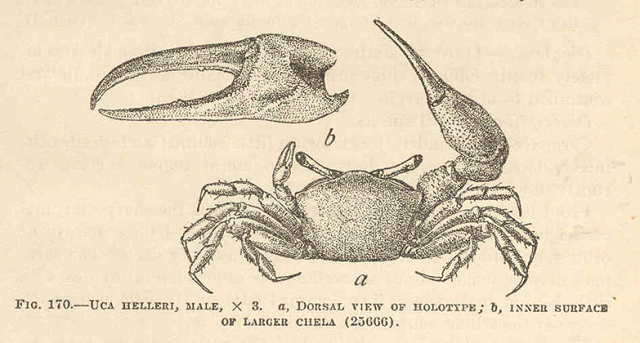Uca genus
This University of Northern Iowa collection contains composite photographs of the Uca genus of fiddler crabs. The collection is a subset of the parent Fiddler Crabs Image Gallery.
-

Figure 004. Uca major
5-2025
Alt Text: Composite photograph of the Uca major fiddler crab which includes several black & white images of different views of the crab, a color photograph, and a distribution map.
Composite Image Description: Figure 4. Uca major. (Herbst, 1782). UNI 29. Collected: 19 July 2007, Bahamas, San Salvador, Pigeon Creek, Eastside Quarry (23.981211, -74.486231). Scale Bar = 10 mm. (A) Dorsal view. (B) Front view. (C) Inner cheliped. (D) Ocular view. (E) Ambulatory. (F) Color Photo. (G) Distribution Map (Finke 2024).:
Species Description: Large species (width < 35 mm). Carapace smooth, carapace length 55% width (Fig. 4A). Frontal region less than 9.4% carapace width (Fig. 4A,D). Eyestalks very long and slim (Fig. 4D). Lower orbit dentations square (Fig. 4D). Anterolateral angle forming sharp, outward-pointing spine. Dactyl and pollex almost same width (Fig. 3B), gap when large cheliped closed. Lower edge of manus with role of uniform-sized tubercles (Fig. 4B,C). Terminus of pollex with sharp spine. On walking legs, merus width is 35% of length. Very few setae in walking legs (Fig. 4E). Found in eastern Mexico, the Caribbean and northern South America (Fig. 4G).
-

Figure 005. Uca maracoani
5-2025
Alt Text: Composite photograph of the Uca maracoani fiddler crab which includes several black & white images of different views of the crab, a color photograph, and a distribution map.
Composite Image Description: Figure 5. Uca maracoani (Latreille, 1802-1803). UNI 40. Collected: 20 July 2010, southwestern Atlantic Ocean, Brazil, Maranhão, São Luis, Praia da Raposa, Rio Munin (-2.415758, -44.100823). Range: Trinidad-Tobago to Paraná, Brazil. Space bar = 10mm. (A) Dorsal view. (B) Front view. (C) Inner cheliped. (D) Ocular view. (E) Ambulatory. (F) Color Photo. (G) Distribution Map (Finke 2024).
Species Description: Large species (width < 45 mm). Carapace granular, carapace length 68.7% width (Fig. 5A); female 72%, male 68%. Eyestalk very long and thin. Frontal region 9.6% carapace width (Fig. 5A,D). Suborbital margin with small, square, dentate tubercles (Fig. 5D). Anterolateral angle sharp, pointing outward. Both dactyl and pollex very broad, no large gap when closed (Fig. 5B,C). Terminus of dactyl and pollex both with sharp spines (Fig. 5C). Ventral manus with very large tubercles (Fig. 5B). Walking legs with few setae. Merus width 43.7% length. Found along the Atlantic coast of South America from Trinidad-Tobago to Florianopolis, Brazil (Fig. 5G). Not widely known in Caribbean. Very old AMNH (#2466) specimen from the Dominican Republic.



